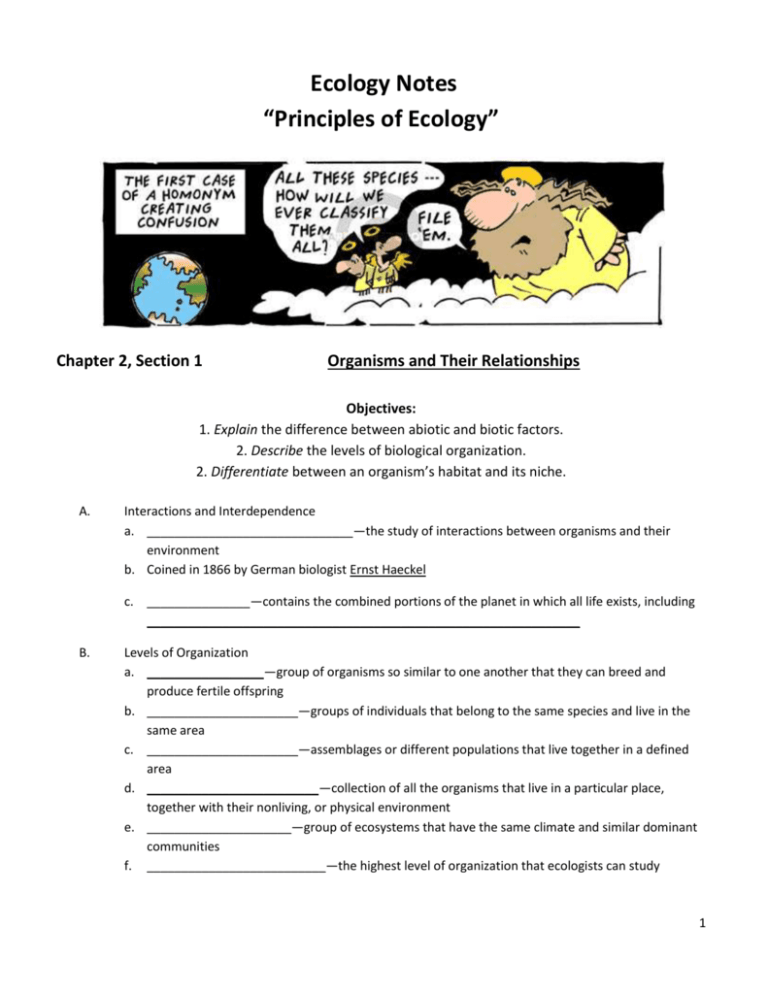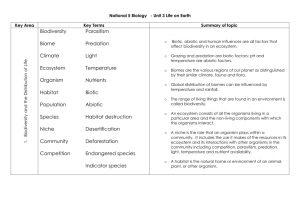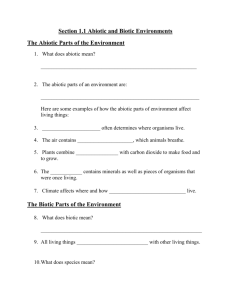Ecology Notes
advertisement

Ecology Notes “Principles of Ecology” Chapter 2, Section 1 Organisms and Their Relationships Objectives: 1. Explain the difference between abiotic and biotic factors. 2. Describe the levels of biological organization. 2. Differentiate between an organism’s habitat and its niche. A. Interactions and Interdependence a. ______________________________—the study of interactions between organisms and their environment b. Coined in 1866 by German biologist Ernst Haeckel c. _______________—contains the combined portions of the planet in which all life exists, including _______________________________________________________________ B. Levels of Organization a. _________________—group of organisms so similar to one another that they can breed and produce fertile offspring b. ______________________—groups of individuals that belong to the same species and live in the same area c. ______________________—assemblages or different populations that live together in a defined area d. _________________________—collection of all the organisms that live in a particular place, together with their nonliving, or physical environment e. _____________________—group of ecosystems that have the same climate and similar dominant communities f. __________________________—the highest level of organization that ecologists can study 1 g. Diagram: C. Biotic and Abiotic Factors a. ______________________ factors—________________________influences on organisms within an ecosystem i. Example: _______________________ ii. What BIOTIC factors might influence, or affect, the bullfrog? 1. ______________________________________________________________ 2. ______________________________________________________________ 3. ______________________________________________________________ b. ______________________________—physical, or nonliving, factors that shape ecosystems i. Example: __________________________________________________________________________ __________________________________________________________________________ ii. Example: Bullfrog iii. What ABIOTIC factors might influence, or affect, the bullfrog? 1. _____________________________________________ 2. _____________________________________________ c. ______________________________ i. Area where an organism __________________________ ii. Includes _____________________________________________________ factors iii. Determines the ________________________________________ of an organism D. The __________________________ a. If the organism’s habitat is its “____________________”, its niche is its “_____________________” b. _____________________—full range of physical and biological conditions in which an organism lives and the way in which the organism uses those condition c. Includes the ________________________________ the organisms eats, how it ____________________this food, and ________________________________________________ 2 E. Community Interactions a. ________________________________ i. Occurs when organisms of the same or different species attempt to use an ecological resource in the ___________________________________________ ii. _______________________—refers to any necessity of life, _________________________________________________________________________ iii. __________________________________________ in nature often results in a winner and a loser—with the losing organism failing to survive iv. ______________________________________________________________—states that no two species can occupy the same niche in the same habitat at the same time b. _______________________________ i. Interaction in which ___________________________________________ and ________on another organism ii. __________________________________ —the organism that does the killing and eating Ex: _____________________ iii. Prey —food organism Ex: _____________________ c. ___________________________________ i. Any __________________________ in which two species __________________________________________________________________________ ii. Symbiosis means “___________________________________________” iii. There are three main classes of symbiotic relationships in nature: 1. ________________________________ a. Both species ________________________ from the relationship b. Ex: ________________________________________ i. _______________________ need ___________________________(bees, butterflies) to reproduce ii. ___________________________ obtain _________________ from the _________________________________ iii. Both are ____________________________________ —MUTUAL 2. _________________________________________ a. One member _______________________ and the other is ___________________________________________________________ b. Ex: __________________________________________________ i. _____________________________, small marine animals, attach themselves to _________________________ ii. __________________________ perform ______________________ to the __________________, but _______________________________________________ iii. As the ____________________________, the ____________________________ are able to eat the food particles that pass by— _______________________________________________________ 3 3. ___________________________________ a. One organism lives _____________________________________ and _______________________ b. The _______________________ obtains _____________________ nutritional needs from the other organism, called the host c. Ex: __________________________________ i. Live inside the _______________________________ of their host ii. _____________________________ most of the food’s nutrients d. Ex: ______________________________________________ i. Live on the ___________________________ of mammals ii. Feed on ______________________________________ of host 4 Chapter 2, Section 2 Energy Flow Objectives: 1. Describe the flow of energy through an ecosystem. 2. Identify the ultimate energy source for photosynthetic producers. 2. Describe food chains, food webs, and pyramid models. A. Producers 1. ____________________________________ is the main energy source for life on Earth 2. In few ecosystems, some organisms obtain energy from other sources than the sun a. inorganic compounds ______________________________________________ b. example: mineral water that flows underground or boils out of hot springs and undersea vents is loaded with chemical energy 3. ______________________________________ a. use energy from the sunlight to _____________________________________________ b. Example: ________________________________ 4. ____________________________________—capture energy from sunlight 5. Energy From the Sun a. __________________________________________—uses light energy to convert carbon dioxide and water into oxygen and sugars/starches b. On land, ________________________ are the main autotrophs c. In water, __________________________ are the main autotrophs 6. Life Without Light a. _________________________________—using chemical energy to produce carbohydrates b. Occurs in very remote places: _________________________________________________________________ B. Consumers 1. _______________________________—__________________________________________ for their energy and food supply; also called “______________________________” 2. There are many different types of heterotrophs/consumers: a. Herbivores—eats _____________________________ Ex: __________________________ b. Carnivores—eats ____________________________ Ex: _________________________ c. Omnivores—eat __________________________________________ Ex: _______________ d. Detritivores—eat ______________________________________________________, otherwise known as “________________________” Ex: ____________________________ e. Decomposers—_________________________________________ Ex: _______________________________________ 5 C. Feeding Relationships 1. _____________________________________ a. Energy stored by producers can be passed through a food chain b. Series of steps in which organisms __________________________________________________________________________ c. Show a ___________________________________ flow of energy in an ecosystem d. Example: ________________________________ ______________________________ _____________________________________________________ e. Diagram: 2. _______________________________ a. Feeding relationships among various organisms in an ecosystem form a _________________________________________________________________________ b. Links all the _________________________________________ in an ecosystem together c. Shows ______________________________ ways of energy in an ecosystem d. Diagram: 3. ____________________________________________________ a. ________________________________________—each step in a food chain or food web b. _____________________________ make the _____________________ trophic level c. _____________________________ make up the ________________________ trophic levels d. Each consumer depends on the trophic level _____________________________ for energy e. Diagram: 6 D. Ecological Pyramids 1. ______________________________________ in an ecosystem can be represented by an ecological pyramid 2. ________________________________________—diagram that shows the relative amounts of energy or matter contained within each trophic level in a food chain or food web 3. Ecologists have three types of pyramids: a. ______________________________ Pyramid i. Only _________________________________________ that is stored in one trophic level is passed on to the next level ii. Only about __________________ of the energy available within one trophic level is ________________________________ to organisms at the next trophic level. iii. The ____________________________that exist between a producer and a toplevel consumer, the _________________________ that remains from the ________________________________________ b. ________________________ Pyramid i. ______________________—the total amount of ___________________________________ within a given trophic level ii. Represents the amount of __________________________________________ for each trophic level in an ecosystem iii. Typically, the _____________________________ is at the _______________ of the pyramid iv. Diagram: c. ____________________________—shows the relative ______________________ at ______________________________________________________ 7 Chapter 2, Section 3 Cycles of Matter Objectives: 1. Describe how the cycling of nutrients contributes to the success of an ecosystem A. Recycling in the Biosphere 1. _____________________________________ to an ecosystem, but organisms _______________________________________________ to survive 2. More than ____________________ of the body is made up of just four elements: _______________________________________________________________________________ 3. Unlike the one-way flow of energy, matter is recycled ___________________________________ 4. _________________________________________________—the passing of elements, chemical compounds, and other forms of matter from one organism to another and from one part of the biosphere to another B. The ________________________________ 1. All living things __________________________________________ to survive 2. _____________________________—process in which water changes from ____________________________________________________________________________ 3. ________________________________—water evaporating from ________________ into the atmosphere 4. _________________________________—tiny droplets that __________________________ 5. _____________________________________—when droplets become large enough, water returns to Earth’s surface in the form of ______________________________________________________ 6. Diagram: 8 C. Nutrient Cycles 1. The __________________________________ a. Carbon plays many roles and is a key ingredient of _________________________________ b. Four main types of processes move carbon through its cycle: i. ___________________________________________ (photosynthesis, respiration) ii. ______________________________________________ (erosion, volcanic activity) iii. ______________________________________________(burial/decomposition of dead organism) iv. ______________________________ (mining, cutting & burning forests, burning fossil fuels) v. Diagram: 2. The ______________________________________ a. All organisms require nitrogen to _______________________________, which _______________________________________ b. Nitrogen gas makes up __________________ of the Earth’s atmosphere c. _______________________________________________—some bacteria convert nitrogen gas into ammonia while others convert ammonia into nitrates and nitrites. d. When organisms die, __________________________________ return nitrogen to the soil as _________________________________. e. _________________________________—other soil bacteria convert nitrates into nitrogen gas; process releases nitrogen back into the atmosphere again f. Diagram: 9 3. The __________________________________________________ a. Phosphorus is essential because it forms part of important life-sustaining molecules such as ________________________________________ b. Phosphorus __________________________________________________ the atmosphere c. Instead it remains mostly on _________________________________________, and in ___________________________________________. d. Diagram: 10 Chapter 3, Section 1 Succession Objectives: 1. Identify what happens when an ecosystem is destroyed 2. Differentiate between primary succession and secondary succession A. Ecological Succession 1. Ecosystems are ____________________________________________ in response to natural and human disturbances a. As an ecosystem changes, _________________________________ gradually die out and ___________________________________________ move in b. __________________________________________—series of predictable changes that occurs in a community over time c. Sometimes succession results from ___________________________________________ in the physical environment d. Sometimes succession results from ___________________________________ from human activity, such as _______________________________________________________ 2. Primary Succession a. _______________________________________ —occurs on surfaces where __________________________________ b. Occurs on the surfaces formed as ___________________________________ build new islands or cover the land with __________________________________________________ c. Occurs on ____________________________________ exposed when glaciers melt d. __________________________________________ —the first species to populate the area 1. Pioneer species on volcanic rock is typically _______________________________ 2. Lichen is made up of ________________________________ and can grow on bare rock 3. As lichens grow, they help ___________________________________the rocks. 4. When they die, lichens add ____________________________ to help form soil in which ________________________________________________ 3. Secondary Succession a. ________________________________________ —succession following a disturbance that destroys a community _____________________________________________________ b. Caused by ______________________, such as ________________, or human activity, such as ________________________ 4. Venn Diagram: 11 Chapter 3 Biomes *You will not be tested on any specific characteristics of each of the individual biomes! Your focus should be on the standard below! Objectives: 1. Investigate the relationships among organisms, populations, communities, ecosystems, and biomes A. Biomes and Climate 1. Biomes—complex terrestrial communities that cover a large area and are characterized by certain soil and climate conditions and particular assemblages of plants and animals 2. _____________________________________—ability to survive and reproduce under certain conditions that differ from their optimal conditions 3. _______________________________________—climate in a small area that differs from the climate around it B. ____________________________________________ 1. Home to ______________________________________ than all other biomes combined 2. ___________________________ —tops of the tall trees (extending 50-80 m above the forest floor) 3. ___________________________—second layer of shorter trees and vines 4. Abiotic factors: hot and wet year-round, thin, nutrient-poor soil 5. Dominant plants: broad-leaved evergreen trees, _________________________________________ 6. Dominant wildlife: sloths, jaguars______________________________________________________ ________________________________________________________ 1. _____________________________________ —tree that sheds its leaves 2. Abiotic factors: generally warm year-round, alternating wet and dry seasons 3. Dominant plants: tall, deciduous trees _________________________________________________________________________________ ________________________________________________________ 4. Dominant wildlife: _________________________________________________________________ ____________________________________________________ 1. Also called “_______________________________________” 2. Abiotic factors: warm temperatures, seasonal rainfall, compact soil, _________________________________________________________________________________ 3. Dominant plants: tall, perennial grasses, __________________________________ 4. Dominant wildlife: lions, leopards, cheetahs, _________________________________________________________________________________ _________________________________________ 1. All deserts are dry—receive _______________________________________ of annual precipitation 2. Can be _____________________ deserts AND _______________________ deserts! 3. Abiotic factors: low precipitation, variable temperatures, _______________________________________________________________________________ 4. Dominant plants: cacti, __________________________________________________________ C. D. E. 12 5. Dominant wildlife: mountain lions, bobcats, ________________________________________________________________________________ F. G. H. I. J. K. L. __________________________________________________ 1. Dense evergreen forests of ____________________________________________trees 2. Also called the “____________________________” 3. Winters are _______________________________________, but summers are mild and long enough to allow the ground to ____________________________ 4. Abiotic factors: long, cold winters, short, mild summers, moderate precipitation, ________________________________________________________________________________ 5. Dominant plants: needle leaf coniferous trees such as spruce and fir, some broadleaf deciduous trees, ____________________________________________________________________________ 6. Dominant wildlife: lynxes, timber wolves, _______________________________________________ ____________________________________________ 1. ________________________________________—layer of permanently frozen subsoil 2. During short, cool summers, the _____________________________________ to a depth of a few centimeters and becomes soggy and wet 3. In winter, the ______________________________________________________________ 4. Abiotic factors: strong winds, low precipitation, short and soggy summers, long, cold, and dark winters, ______________________________________________________________ 5. Dominant plants: ground-hugging plants such as mosses___________________________________________________________________ 6. Dominant wildlife: few mammals that can withstand the harsh conditions, musk ox, Arctic foxes, _____________________________________________________________________ Aquatic Biomes 1. Divided into _____________________________________________ 2. Freshwater includes ______________________________________________________________ 3. Marine includes ___________________________________________________________________ Freshwater 1. Abiotic factors: ____________________________________________________________________ 2. Biotic factors: _____________________________________________________________________ Open Ocean 1. Abiotic factors: _________________________________________________________________________________ _________________________________________________________________________________ 2. Biotic factors: _____________________________________________________________________ Rocky Intertidal 1. Abiotic factors: ____________________________________________________________________ 2. Biotic factors: _____________________________________________________________________ Estuaries 1. Estuaries—____________________________________________________________________ 2. Contain a _____________________________________________________________________ 3. Abiotic factors: ____________________________________________________________________ 4. Biotic factors: _____________________________________________________________________ 13








